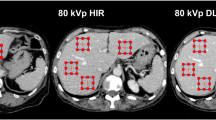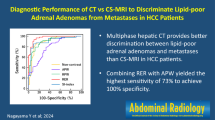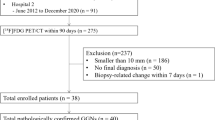Abstract
Objective
The aim of this study was to evaluate the efficacy of three-phase contrast material-enhanced MRI in assessing no-surgical treatment response in peripheral bronchogenic carcinoma preliminarily.
Methods
Twenty-two patients with bronchogenic carcinoma after no-surgical treatment underwent three-phase contrast material-enhanced MRI. Three scans were obtained at 25 s, 120 s and 180 s respectively after nonionic contrast material was administrated via the antecubital vein at a rate of 2 mL/s by using an autoinjector. Precontrast and postcontrast signal intensity on every scan was recorded. Peak Height (PH) and Maximum Enhancement (Emax) were calculated. Enhancement pattern was evaluated on the images obtained at 120 s and 180 s after injection of contrast medium.
Results
Precontrast signal intensity, postcontrast signal intensity at 120 s and 180 s were 478 ± 108, 926 ± 209 and 1050 ± 252. PH (571 ± 225) and Emax (119 ± 49) of bronchogenic carcinoma after no-surgical treatment were significantly lower than those of bronchogenic carcinoma without any therapy (mean PH 655, mean Emax 150) (t = 2.178, P = 0.005 < 0.05, t = 4.196, P = 0.001 < 0.05). Six cases among 22 appeared homogeneous enhancement at 180 s. At 120 s, there were 4 cases with inhomogeneous enhancement, 1 case with homogeneous enhancement, 1 case with peripheral enhancement among the 6 cases.
Conclusion
Bronchogenic carcinoma after no-surgical treatment shows a gradual increase to the PH after administration of contrast material. Three-phase contrast material-enhanced MRI can reflect the blood supply of bronchogenic carcinoma and might be effective approach for evaluation of no-surgical treatment response in bronchogenic carcinoma.
Similar content being viewed by others
References
Li SJ. Preliminary assessing no-surgical treatment response in bronchogenic carcinoma with changes in enhancement area size. Chinese-German J Clin Oncol, 2009, 8: 397–401.
Brundage MD, Davies D, Mackillop WJ. Prognostic factors in nonsmall cell lung cancer: a dacade of progress. Chest, 2002, 122: 1037–1057.
Zhang XD, Lu JG, Yang l, et al. Weekly paclitaxel liposome in the treatment of 37 cases with advanced non-small cell lung cancer in elderly. China Cancer (Chinese), 2008, 17: 720–722.
D’Amico TA. Angiogenesis in non-small cell lung cancer. Semin Thorac Cardiovasc Surg, 2004, 16: 13–18.
Li SJ, Xiao XS, Liu SY, et al. Blood flow patterns of solitary pulmonary nodules with enhancement: clinical value of multi-slice spiral CT. Chin J Radiol (Chinese), 2004, 38: 1062–1068.
Li SJ, Xiao XS, Liu SY, et al. Correlation of the quantifiable parameters of blood flow pattern derived with dynamic CT in solitary bronchogenic adenocarcinoma. Chinese-German J Clin Oncol, 2007, 6: 345–349.
Fujimoto K, Abe T, Muller NL, et al. Small peripheral pulmonary carcinomas evaluated with dynamic MR imaging: correlation with tumor vascularity and prognosis. Radiology, 2003, 227: 786–793.
Yang CS, Xiao XS, Liu SY, et al. Blooo flow pattern and quantitative study in solitapy pulmonary nodules with dynamic contrast-enhanced NHA MRI. J Shanghai Second Mili Medl Univ, 2007, 19:41–45.
Lin LZ, Tao ZG, Zhou DH. Multicencter Study on comparison of response rate between WHO criteria and RESCIT for lung cancer. Chin J Clin Oncol (Chinese), 2006, 11: 253–255.
Miles KA, Charnsangave Cj, Lee F T, et al. Application of CT in the investigation of angiogenesis in oncology. Acad Radiol, 2000, 7: 840–850.
van den Haff J. Assessment of lung cancer perfusion by using patlak analysis: what do we measure? Radiology, 2007, 243: 907–908.
O’Byrne K J, Koukourakis MI, Giatromanolaki A, et al. Vascular endothelial growth factor, platelet-derived endothelial cell growth factor and angiogenesis in non-small-cell lung cancer. Br J Cancer, 2000, 82:1427–1432
Quan SN, MBBS, MRCP, et al. Lung cancer perfusion at multi-detector row CT: reproducibility of whole tumor quantitative measurements. Radiology, 2006, 239: 547–553.
Li H, Lindenmeyer F, Grenet C, et al. AdTIMP-2 inhibits tumor growth, angiogenesis, and metastasis, and prolongs survival in mice. Hum Gene Ther, 2001, 12: 515–526.
Author information
Authors and Affiliations
Corresponding author
Rights and permissions
About this article
Cite this article
Li, S., Zhu, F., Cui, X. et al. Preliminary assessing no-surgical treatment response in bronchogenic carcinoma with three-phase contrast material-enhanced MRI. Chin. -Ger. J. Clin. Oncol. 9, 444–447 (2010). https://doi.org/10.1007/s10330-010-0657-7
Received:
Revised:
Accepted:
Published:
Issue Date:
DOI: https://doi.org/10.1007/s10330-010-0657-7




